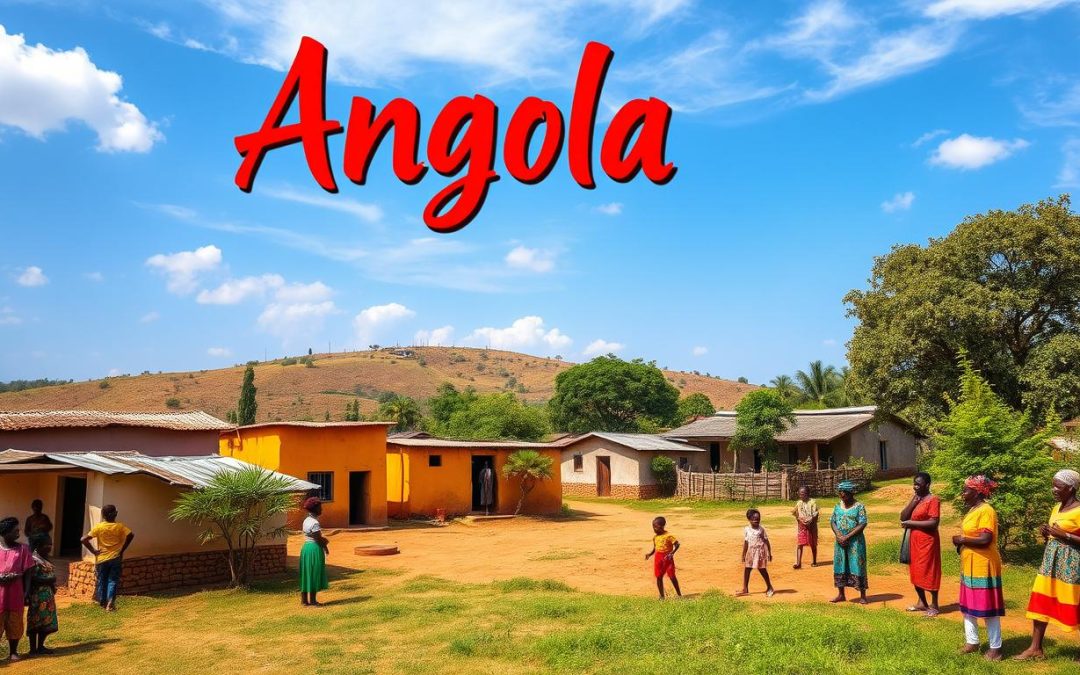Have you ever thought about how one language can bring together a nation with over 40 ethnic tongues? In Angola, Portuguese is the key that holds a very diverse population together. It connects people in both cities and rural areas.
Angola’s language scene is a mix of history and cultural strength. Portuguese, the official tongue, is spoken by about 71% of the people. With 46 languages spoken across the country, Angola shows a unique mix of languages.
Language tells the story of how people adapt, survive, and find their identity in Angola. You’ll see how Portuguese went from a colonial language to a symbol of unity. It connects communities across this vast African land.
Key Takeaways
- Portuguese is the official language spoken by 71% of Angolans
- 46 different languages coexist in Angola’s linguistic ecosystem
- Urban areas have higher Portuguese language penetration (85%)
- Bantu languages represent the majority of indigenous tongues
- Language reflects Angola’s complex historical and cultural journey
Introduction to Angola’s Linguistic Landscape
Angola is a vibrant multilingual society. Its languages tell the story of cultural diversity and historical complexity. The nation’s language mix includes indigenous languages and colonial influences, creating a unique way of communication.
The Bantu languages are at the heart of Angola’s language landscape. They represent centuries of cultural heritage. These languages are still important in daily life across different regions.
Language Diversity Overview
Angola’s language profile is complex, showing the country’s diverse ethnic makeup. The main languages are:
- Portuguese (official language)
- Umbundu (23% of population)
- Kikongo (8.8% of speakers)
- Kimbundu (7.85% of population)
Historical Language Development
The history of languages in Angola is linked to colonial history and cultural interactions. Portuguese colonization introduced a language that became the main official language.
“Language is the road map of a culture. It tells you where its people come from and where they are going.” – Rita Mae Brown
Current Language Distribution
Today, Angola’s language map is fascinating. Portuguese is used by about 85% in urban areas. But, indigenous languages are strong in rural areas. Umbundu, for example, is common in the center-west, keeping its cultural value.
Understanding Angola’s language diversity is key. It shows the balance between colonial heritage and preserving indigenous languages. Each language has its own story, tradition, and view of this dynamic African nation.
Portuguese: The Official Language of Angola
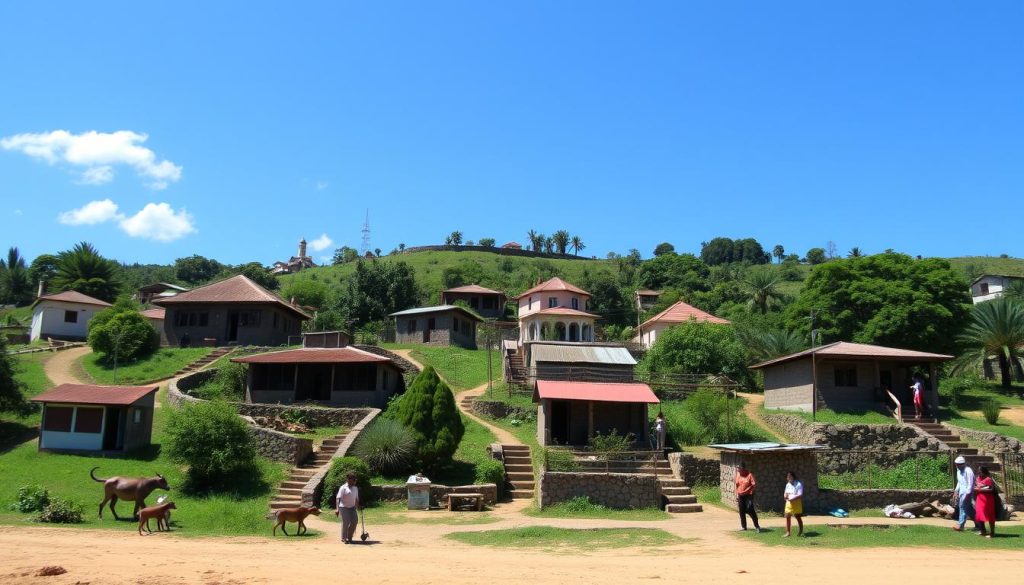
Portuguese has a long history in Angola, becoming the official language during the colonial era. Since gaining independence in 1975, it has united diverse ethnic groups. Today, 71% of Angolans speak Portuguese, making it key for communication and cultural identity.
The linguistic landscape of Angola shows interesting facts about Angolan Portuguese:
- 39% of Angolans speak Portuguese as their mother tongue
- 85% of urban populations communicate in Portuguese
- 49% of rural populations use the language
Angolan Portuguese has its own unique blend. It combines colonial language traditions with Bantu influences. Words like jindungo, minhoca, and sembala show the creative exchange over centuries.
“Language is the roadmap of a culture. It tells you where its people come from and where they are going.” – Rita Mae Brown
Economic activities and markets have made Portuguese even more dynamic. It now connects different ethnic groups.
| Language Category | Percentage of Speakers |
|---|---|
| Portuguese (Mother Tongue) | 39% |
| Urban Portuguese Speakers | 85% |
| Rural Portuguese Speakers | 49% |
The language’s evolution shows Angola’s complex culture. Portuguese acts as a bridge between tradition and modern identity.
The Rise of Portuguese in Urban Areas
Angola’s language scene is changing fast, with Portuguese becoming key in cities. It’s especially popular among the young. This shows how language shapes urban life.
In Angola, city languages are changing a lot. Portuguese is now the main way people talk, showing the country’s history and society. Studies highlight big differences between city and country languages.
Statistical Insights into Portuguese Usage
Studies show how Portuguese use varies by area:
- 85% of city folks speak Portuguese at home
- 49% of rural folks use Portuguese often
- More than 14 million in Africa speak Portuguese first
Urban vs Rural Language Dynamics
Cities like Luanda have a special language scene. Here, youth communication mostly happens in Portuguese. This shows a big change in language use between generations.
Impact on Youth Communication
“Language is the road map of a culture. It tells you where its people come from and where they are going.” – Rita Mae Brown
Young Angolans are choosing Portuguese more and more. This change is linked to better social status, education, and city life. It’s not just about language; it’s a big social shift.
By 2100, Africa will have most Portuguese speakers, with Angola leading the way. This shows how language is evolving.
Angolan Portuguese: A Unique Dialect
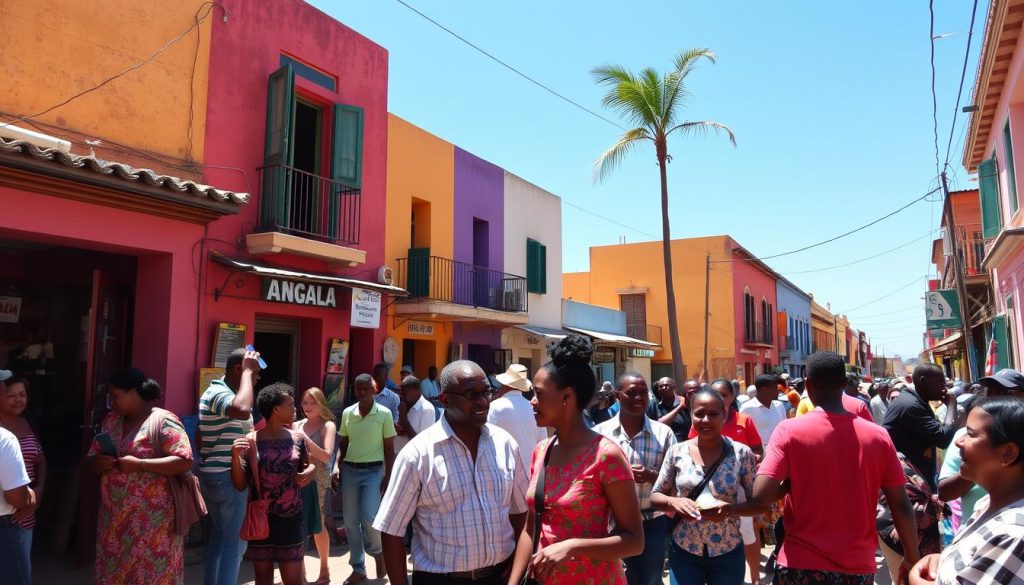
Exploring Angolan Portuguese opens a window into a rich cultural heritage. This dialect is more than words; it’s a vibrant expression of Angola’s history and society.
Angolan Portuguese has its own unique features. Local languages have shaped its vocabulary, pronunciation, and grammar. These differences make the dialect truly special.
- Distinctive pronunciation patterns
- Unique vocabulary borrowed from local languages
- Grammatical structures influenced by indigenous speech
In Angola, Portuguese is key for communication. The census shows 71% of Angolans speak Portuguese at home. This number goes up to 85% in cities, showing the dialect’s urban importance.
“Language is the road map of a culture. It tells you where its people come from and where they are going.” – Rita Mae Brown
The Angolan dialect has also influenced Portuguese in Portugal. Younger generations in Portugal are using words and expressions from Angola. This shows the dialect’s cultural impact.
| Language Characteristic | Angolan Portuguese Feature |
|---|---|
| Vocabulary Influence | Strong indigenous language integration |
| Urban Usage | 85% of urban population |
| National Speakers | 12 million native speakers |
Exploring Angolan Portuguese shows a dynamic, evolving language. It captures the essence of Angola’s multicultural identity. It’s not just for talking; it’s a living piece of Angola’s history.
Major Indigenous Languages
Angola’s language scene is rich and varied, showing the country’s deep cultural roots. Portuguese is the main language for official talks. But, the indigenous languages are key to keeping local traditions alive.
Umbundu: The Language of the Central Highlands
Umbundu is the most spoken indigenous language in Angola, with about 38% of the people using it. It’s mainly spoken by the Ovimbundu people in the central highlands and coastal areas. This language keeps the cultural ties strong among its speakers.
- Spoken by approximately 38% of Angolans
- Concentrated in Central Highlands region
- Critical to Ovimbundu cultural identity
Kimbundu’s Cultural Significance
Kimbundu is another important language, used by about 25% of Angolans. The Mbundu people use it to keep their culture and traditions alive. It’s a key part of their social life.
“Language is the road map of a culture. It tells you where its people come from and where they are going.” – Rita Mae Brown
Kikongo: Regional Linguistic Influence
Kikongo is spoken by around 10% of Angolans. The Kongo people use it in many areas, showing its lasting importance. It’s a strong part of their culture, even with Portuguese being widely used.
| Language | Percentage of Speakers | Primary Regions |
|---|---|---|
| Umbundu | 38% | Central Highlands |
| Kimbundu | 25% | Northern Regions |
| Kikongo | 10% | Western Provinces |
These languages are more than just ways to talk. They hold Angola’s cultural history and diversity alive.
National Language Policy and Recognition
Angola’s language policy is complex, focusing on both Portuguese and indigenous languages. The government sees these languages as key to keeping national identity alive.
The country’s language policy covers several important areas:
- Official recognition of Portuguese as the primary language
- Preservation of indigenous Bantu languages
- Support for linguistic diversity
- Promotion of multilingual education
Even though Portuguese is the official language, Angola values its 46 indigenous Bantu languages. This policy ensures these languages are recognized and protected.
“Language is the roadmap of a culture. It tells you where its people come from and where they are going.” – Rita Mae Brown
The national language policy tries to balance Portuguese with indigenous languages. This helps with communication, cultural identity, and social unity across different areas and ethnic groups.
| Language Category | Percentage of Speakers | Official Status |
|---|---|---|
| Portuguese | 71% | Official Language |
| Umbundu | 22.96% | National Language |
| Kikongo | 10.63% | National Language |
| Kimbundu | 7.82% | National Language |
The government keeps working on language policy and recognition. This ensures Angola’s cultural richness and effective communication.
French Influence in Cabinda Region
The Cabinda region is special because of its language. It’s a pocket area in Angola, showing a unique mix of cultures. This mix is seen in its language.
Border Regions and Language Dynamics
Cabinda is close to French-speaking countries. This has made French a big part of its language scene. It’s a blend that changes how people talk in Cabinda.
- 90% of literate population speaks French
- Only 10% speak Portuguese
- Strong influence from neighboring French-speaking countries
French vs Portuguese Speaking Statistics
In Cabinda, French is the main language, unlike in most of Angola. Portuguese is less common here. French is the key to talking in Cabinda.
| Language | Percentage of Speakers | Primary Usage |
|---|---|---|
| French | 90% | Formal communication |
| Portuguese | 10% | Limited official interactions |
The linguistic landscape of Cabinda demonstrates how geographical borders can profoundly shape language dynamics.
Knowing about French in Cabinda shows the area’s special culture. It’s more than just talking. It’s a mix of history, geography, and culture.
Educational Language Programs
Angola’s language education scene is complex. It mixes many languages and faces historical hurdles. The country’s bilingual programs try to close gaps by adding national languages to schools. Yet, Portuguese stays the main teaching language.
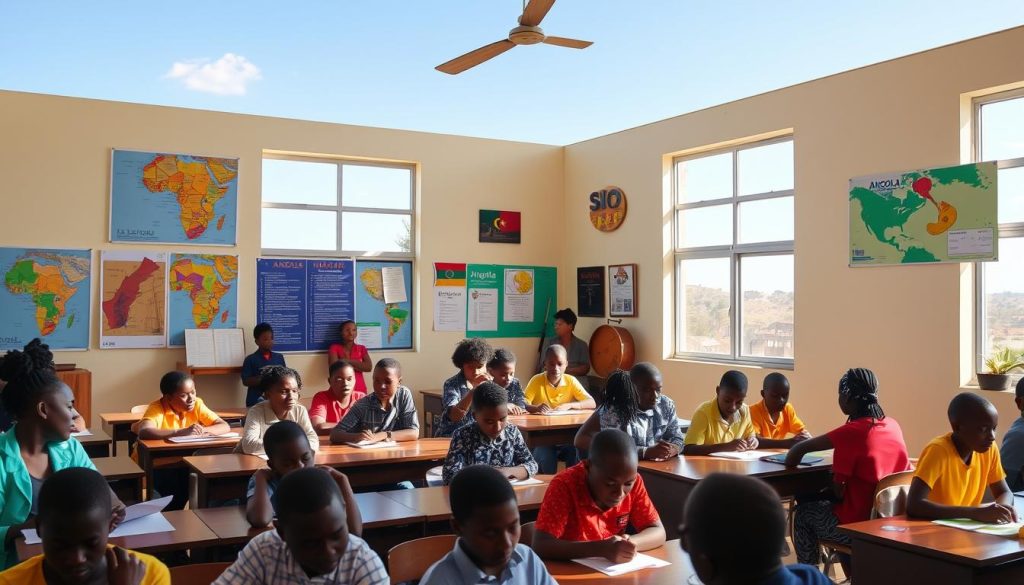
- Six of Angola’s 12 national languages are taught in schools
- Portuguese is still the main teaching language
- English is becoming a key subject from grade seven on
But, there are big challenges in language education. Many schools face:
- Shortage of teaching materials
- Not enough trained teachers
- Only 5% of schools have internet
“Language is the roadmap of a culture. It tells you where its people come from and where they are going.” – Rita Mae Brown
Bilingual programs are changing. They focus on getting students ready for the world. The government wants to keep native languages alive. But also, ensure students can speak Portuguese and English well.
Reforms show Angola’s dedication to language variety. English lessons are growing. This is because of the need for international skills, especially in the oil industry.
Media and Broadcasting Languages
Angola’s media world is full of different languages, with radio and print media being key. They help share messages and show off culture. Knowing about media languages in Angola shows how Portuguese and local languages mix.
Radio is a big deal for language in Angola. It broadcasts in fourteen major languages. This way, more people can understand what’s being said in their own language.
Radio Broadcasting Diversity
The radio in Angola is very open to different languages:
- Portuguese is the main language used
- Umbundu, Kimbundu, and Kikongo get a lot of airtime too
- About 14 national languages are on the radio
Print Media Language Distribution
Print media in Angola mostly uses Portuguese. About 71% of people speak Portuguese. This makes Portuguese a big choice for media.
“Language is the road map of a culture. It tells you where its people come from and where they are going.” – Rita Mae Brown
Media languages in Angola do more than just share news. They keep cultural ties strong. They help connect cities and towns through many languages.
Foreign Language Presence
Angola’s language scene goes beyond just Portuguese. It welcomes many foreign languages, shaping its global ties. Schools and businesses are now reaching out to the world through these languages.
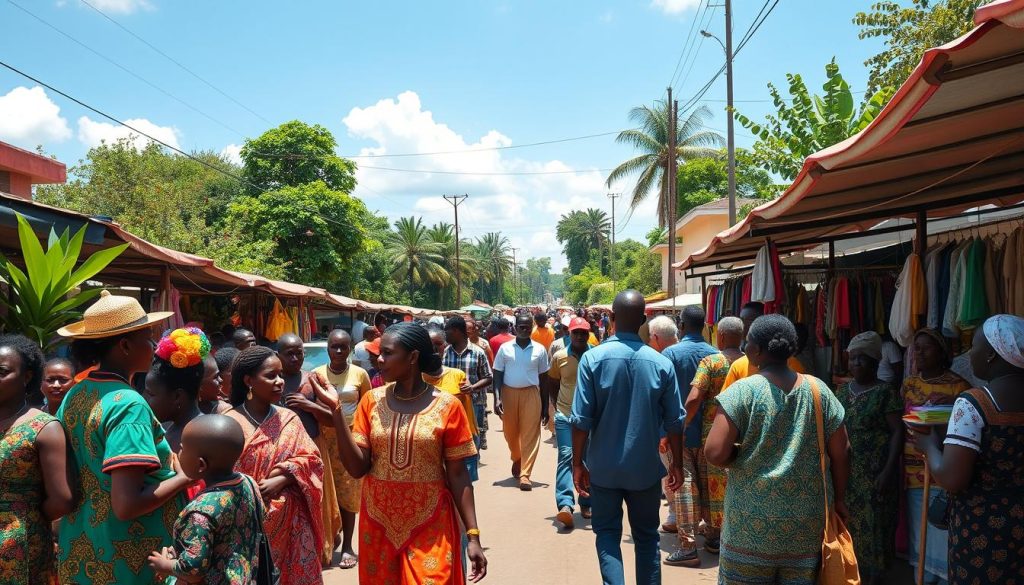
English is leading the way as Angola’s top foreign language. The government is pushing for more English education. This is to boost business and connect with the world.
Schools in cities are adding English to their curricula. This prepares students for the global job market.
- English is becoming mandatory in many educational institutions
- Growing demand in business and professional sectors
- Increasing international communication needs
The Chinese language is also making a big impact in Angola. About 300,000 people speak Chinese, thanks to big investments and diplomatic ties.
| Foreign Language | Approximate Speakers | Primary Sector of Influence |
|---|---|---|
| English | Growing rapidly | Education, Business |
| Chinese | 300,000 | Economic Investments |
Foreign languages are changing how Angola talks to the world. They open doors to cultural exchange and economic growth.
“Languages are bridges connecting cultures and opportunities” – Angolan Education Minister
Angola: Official and widely spoken languages
Angola is a multilingual nation with a rich language landscape. This diversity shows the country’s cultural heritage. It reflects historical interactions, cultural resilience, and national identity.
Portuguese is the official language, spoken by almost 80% of people. This is due to Angola’s colonial history. It has created a common way of communication in both cities and rural areas.
- Portuguese is the mother tongue for 39% of Angolans
- Urban areas show 85% Portuguese usage
- Rural regions maintain 49% Portuguese speaking rates
Angola also has many indigenous languages. The Bantu language family is the most common. Three major languages stand out:
- Umbundu (23% of population, ~5.9 million speakers)
- Kikongo (8.24% of Angolans)
- Kimbundu (approximately 1.7 million speakers)
“Language is the roadmap of a culture. It tells you where its people come from and where they are going.” – Rita Mae Brown
The government values preserving languages and is working on plans. They aim to make English a compulsory subject in schools. This will add to Angola’s rich multilingual environment.
Conclusion
Exploring Angola’s languages shows a rich mix of cultures. The country must balance keeping local languages and using global ones. With over 30 ethnic groups, saving these languages is key.
Angola’s language story is one of cultural strength. Even though Portuguese is common, languages like Umbundu and Kimbundu are still important. These languages help keep community ties strong.
Education and media are crucial for saving Angola’s languages. By teaching and using these languages, Angola can keep its culture alive. It also prepares for the world.
Angola’s languages are more than words; they show the nation’s spirit. This language world is changing, linking the past to the future. Saving these languages will shape Angola’s culture for years to come.
The above is subject to change.
Check back often to TRAVEL.COM for the latest travel tips and deals.
Here are some Tours & Sightseeing suggestions that might pique your interests!
